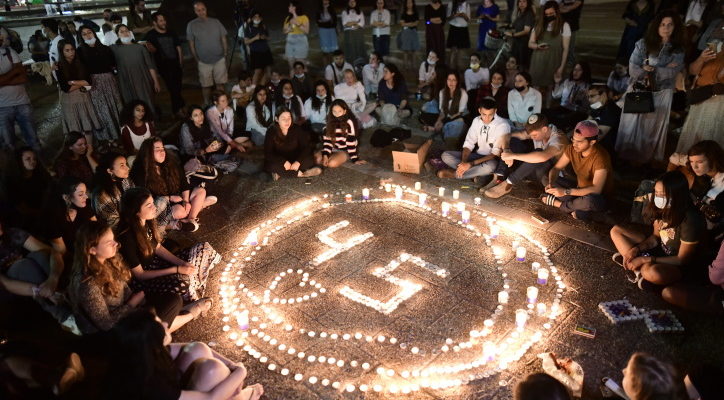Israelis wept as the victims took on names and faces in the days after the tragedy.
By David Isaac, World Israel News
The Mount Meron tragedy reflected the best and worst of Israeli society.
The best could be seen in its wake. Israel unified around the victims and their families. Over 2,200 units of blood were donated in a single day. Sunday was declared a national day of mourning.
Prime Minister Benjamin Netanyahu said while visiting recovering victims of the tragedy at Rambam Hospital in Haifa: “One of the parents told me the sentence that summarizes everything: ‘Here one reveals that the people of Israel has one heart.’”
Israeli President Reuven Rivlin, who had recently warned the country was dangerously divided, said “At the end of the day, and however hard it is for us to remember it, we are better than they tell us, more united than the election campaigns try to suggest. We are more committed to each other than this or that person with an ax to grind would have it. At the moment of truth, we are one human fabric.”
The outpouring during a time of national sorrow was especially poignant as the victims were haredim, or ultra-Orthodox Jews, a segment of the population scorned by many for its insularity and hostility to Zionism. Antipathy toward the haredim has been exacerbated during corona, when it was felt that they ignored pandemic guidelines.
All that was pushed aside after the catastrophe – the worst civil disaster in Israel’s history – which took 45 lives on a festive holiday marked by dancing, singing and bonfires celebrating a famous Torah sage from the second century C.E. and, as chance would have it, the end of death from an ancient plague.
Israelis wept as the victims took on names and faces in the days after the tragedy. There were two brothers, 14 and 9 ½, who lost their lives. There was the new father of a baby girl, only two weeks old. A 3-year-old girl walked among mourners asking where her father was. At another funeral, a little boy, barely old enough to read, struggled through the Mourner’s Kaddish at his father’s grave.
The worst, or at least most dysfunctional, aspects of Israel were on display mainly in retrospect, as it soon became apparent that endless warnings had been made about Mount Meron and that the Lag BaOmer festival was a disaster waiting to happen.
The state comptroller’s office had already issued reports in 2008 and 2011 warning of the dangers. In 2016, the Israeli police noted that 223,000 had arrived in the span of two days – “15 times that permitted by law.”
Rabbi Eli Ben-Dahan, a former director general of the chief rabbinate who had visited Meron for some 40 years, admitted in Sunday’s Israel Hayom that “the fear of a mass disaster had nested in me for many years.”
The immediate cause of the disaster was a tunnel sided with corrugated metal and, disastrously, a metal flooring sloped at a sharp angle. It became wet with spilled water, grape juice and sweat as thousands crossed it. During the exit from the event after midnight on Friday, people began to slip and fall in the tight space, leading to a human avalanche of death and misery.
The makeshift tunnel was representative of the patchwork, subpar infrastructure throughout the holy site, which isn’t under the control of any one entity but broken into several Hasidic fiefdoms. The tragedy, for example, took place at the Toldot Aharon compound run by the Toldot Aharon Hasidic sect.
Israeli journalist Akiva Bigman says that Mount Meron symbolizes the deep divide and distrust that exists between the haredi community and the State of Israel.
For years, officials have tried to turn Mount Meron into a modern, organized holy site similar to the Western Wall, but haredim have resisted those efforts. In 2011, when Minister of Finance Yuval Steinetz tried to impose state control on the area, posters in Hasidic neighborhoods decried the effort: “We have heard with horror that the rulers want to take control of the holy ground… It will not be.” When Yair Lapid tried the same thing, haredi leaders said that “the rule of evil” wanted to take control of the site.
In the end, a compromise was reached, says Bigman. Clearly, the compromise wasn’t enough.
The recriminations on display since the tragedy even extend to criticism of the criticism. Some say it’s too early to talk about apportioning blame or delving into the causes. Others says this is precisely the time.
When we talk about Israeli nature, what we really mean is Jewish nature, and as Max Nordau, one of Zionism’s founders, noted: “The Jew learns not by way of reason but from catastrophes.”
The Jews have their catastrophe. We predict Mount Meron will be placed under state authority in short order and an infrastructure to rival that of the Western Wall will be built in the area.
Jews learn from catastrophes. Fortunately, one is often enough.
David Isaac is managing editor of World Israel News.




